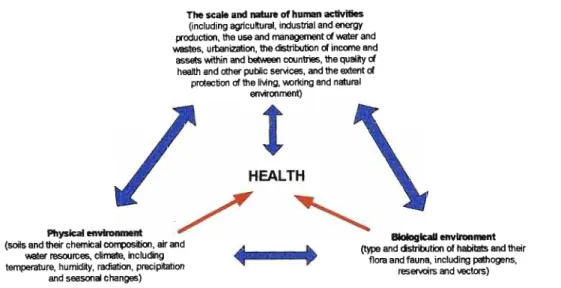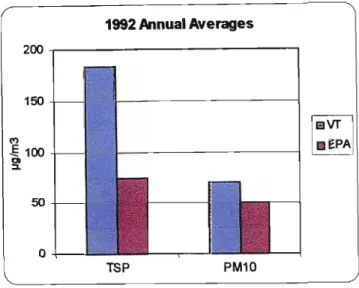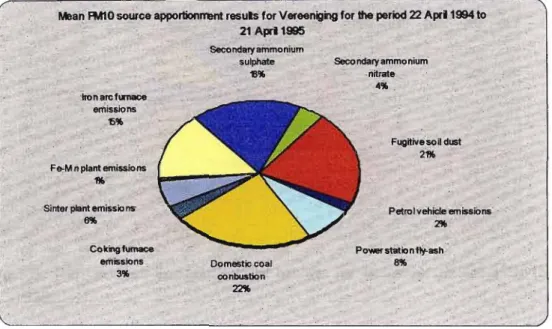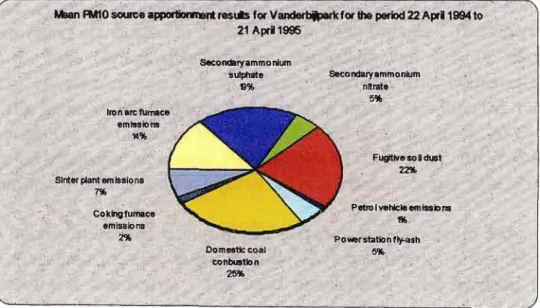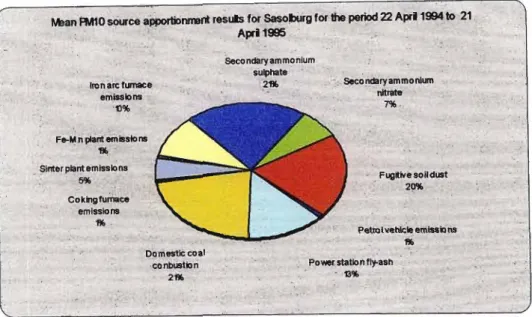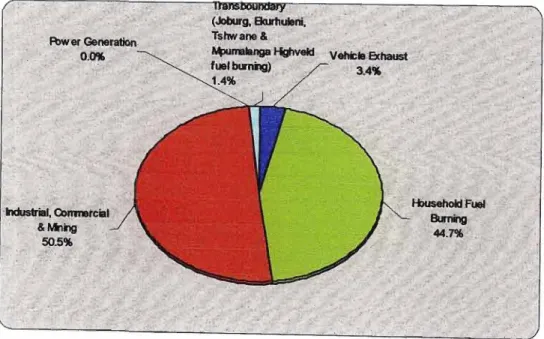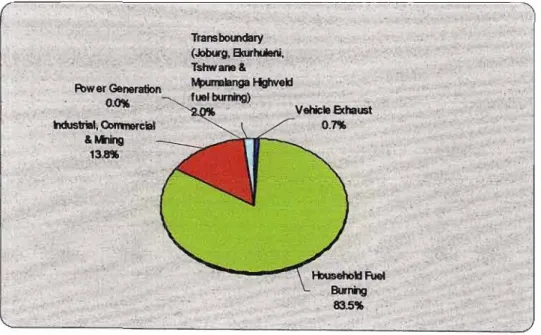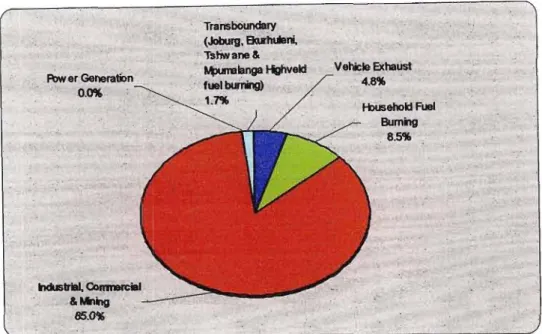Incidence of asthma in a cohort of young adults who spent their formative years in the Vaalt Triangle, South Africa. 39 percent of the survey population indicated that they still lived in the city where they were born.
HIV HP
ISAAC
NHANES NH3
PEACE REL
SAPALDIA SCARPOL
Th1 is a subset of helper-inducer T lymphocytes that synthesize and secrete interleukin-2, gamma interferon and interleukin-12.
CHAPTER ONE
Exposure
It is clear from Figure 1.2 that there are different routes of human exposure, namely inhalation, ingestion and skin contact. When an individual is exposed to contaminated air, food, water and/or soil, any or all of these media may contribute to the individual's total exposure through one or more of the routes of ingestion, inhalation and skin contact.
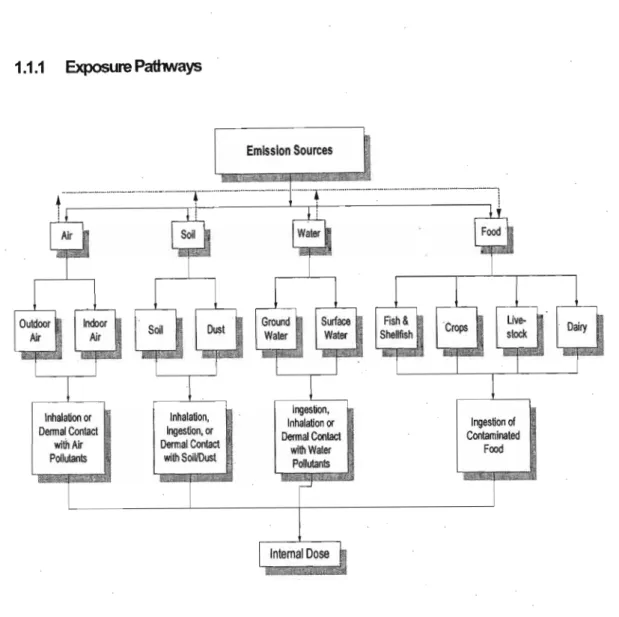
Children and adoIescenfs exposure
- Temporal and spatial patterns of exposure
When no indoor sources of specific pollutants exist, indoor concentrations will depend on outdoor air concentrations and factors such as ventilation rate, and the reactivity of the pollutant. These individuals formed part of the Vaal Triangle Air Pollution Health Study (VAPS) conducted during the early nineties.
Problem Statement
Klerksdorp, a less polluted area, found that children in the Vaalttrekanten had a 134% higher risk of developing upper respiratory diseases and a 203% higher risk.
Objectives of the study
Research Question
Key Questions
Does the risk of having upper respiratory diseases increase significantly with time spent in a polluted area during developing years? What is the risk profile for respiratory disease in adults who spent their formative years in a polluted area in South Africa.
Hypothesis Null Null
- New Zealand study
- Studies in the United S1ates
- Studies in Gennany
Combined data from 21 of the cities showed a statistically significant increase of 0.6% in daily all-cause mortality for every 10 !.Ig/m3 increase in PM10 (Brunekreefand Holgate, 2002). From the data of six of the European cities it was found that for every 50.
A.2 The Birtfl.to.ten s1udy
In this large study, it was found that the prevalence of asthma varied between countries (from -2--35%) and even between cities (from-2--20%) within the same country. Pollen and fungal spores are risk factors for the occurrence of hay fever, as was found in the VAPS study.
CHAPTER THREE
- Air quality monitoring network during V APS
- Pollutants monitored
- Main air pollution findings during the Vaal Triangle study
The US-EPA standard and the South African guideline (both 120 ppb) were exceeded at the latter site. At the time of the Vaal Triangle study, a 24-hour World Health Organization (WHO) TSP guideline of 180 IJg/m3 was available.
Air pollution in the VaaJ Triangle after 1993 (afterV APS)
Particulate matter remains a cause for concern in the Vaal Triangle, especially in areas where coal is fired. Once again it is clear that concentrations may be higher in industrial and coal-fired residential areas.
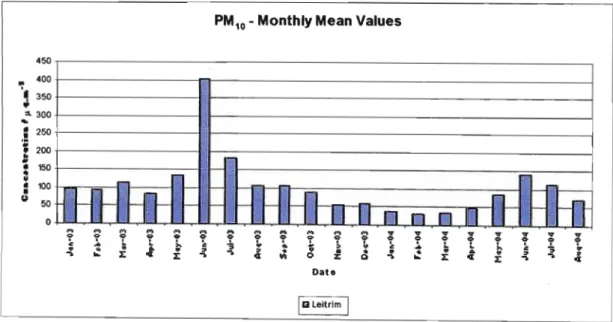
Air quality monitoring results for nitrogen dioxide after 1993
Considering the post-VAPS period, hourly ozone averages in the Vaal Triangle were available for only one location. The highest monthly average concentration for 03 in the industrial area for the period January 2003 to August 2004 was 48 ppb, recorded in October 2003. The highest concentration for the residential coal area was 38 ppb, also recorded in October 2003 (Sasoland Eskom, 2004).
Risk Transition On Developing Countries
From Figure 4.1 it is evident that there is a transition in mortality risk from mainly infectious diseases, perinatal and maternal causes in less developed countries to diseases of the circulatory system and an increase in cancer in more developed countries. The incidence of liver cancer in Iowa and middle-income countries is high, with more than half of the cases in China, but sub-Saharan Africa also has a high incidence. Based on the above, it was decided to include questions in the questionnaire that will attempt to obtain information on the lifestyle and consumption habits of the study population.
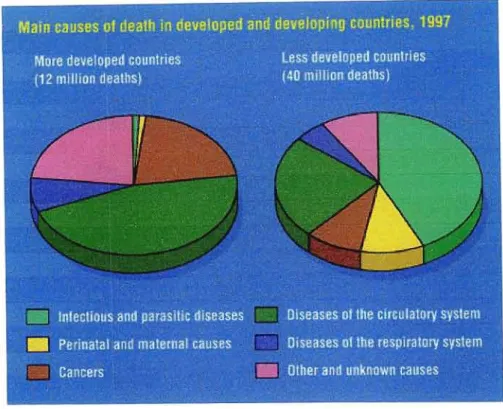
Passive surveillance
- Co-ordination
The status quo of epidemiological services in South Africa in 1977 revealed that there were several fields where very little had been done in terms of epidemiological input. Statistics on the reportable diseases in South Africa are still released periodically (Department of Health, 2003). The South African Demographic and Health Survey (SADHS, 1998) (the most recent for which results are available) found that the IMR in South Africa for the ten years preceding the survey was 45.4 (so a significant decrease from 85 in 1970) .
Epidemiological transition of communicable diseases in South Africa The communicable diseases that were and still are some of the main role The communicable diseases that were and still are some of the main role
Although the last confirmed case in South Africa occurred in 1989, the country remains at risk of the disease from neighboring countries. It is estimated that 40% of TB patients in South Africa are infected with HIV (Department of Health, 2000b). It is clear from these statistics that cholera is still a major problem in South Africa.
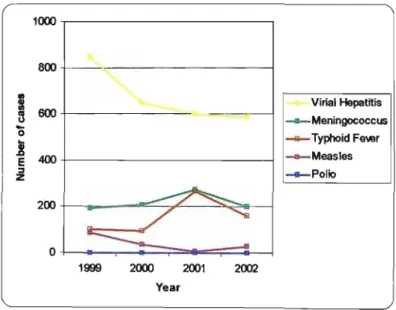
Summary Chapter 4
Therefore, residents of large cities in developing countries are exposed to both "traditional" and "modern" pollutants. This change in the composition of air pollution can alter the toxicity potential of ambient air (Brunekreef and Holgate, 2002). This change in the composition of air pollution can alter the toxicity potential of ambient air (Brunekreef and Holgate, 2002).
Methodology 5.1 Study design 5.1 Study design
The average wind conditions in this area are dominated by the latitudinal high pressure (HP) system. Sinking air (associated with the HP system) causes adiabatic heating, resulting in a drying of the atmosphere and an increase in atmospheric stability. Seasonal differences in the depth of the mixing layer, together with the stability of the atmosphere, have a great influence on the potential of pollution dispersion in the area and thus on the surface concentrations of pollutants (Tosen et. al., 1992).
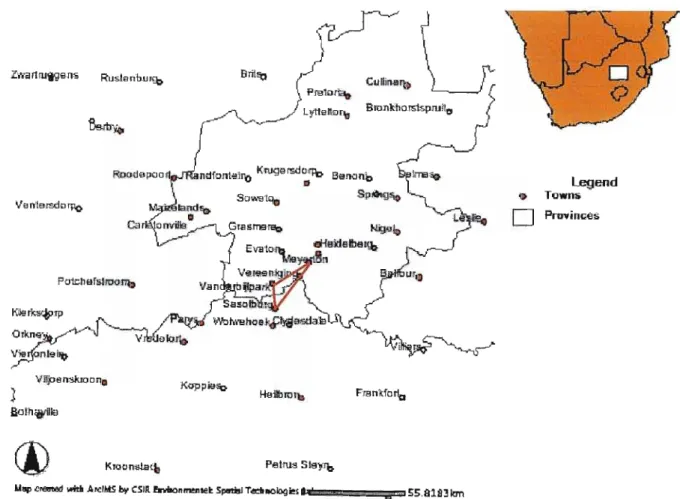
Study population
Topographically induced drainage flows on clear nights are east to southeast (Tosen et. al., 1992). Since April, the HP system has been going strong; causing the summer northerly winds to change to westerlies, while they intensify between April and September (Tosen et. al., 1992). In winter, nocturnal surface inversions occur about 80% of the time, with an average strength of 5 °C and an average depth of 300 m.
Sampling strategy
Six of these had died of unnatural causes, 23 were working abroad without a fixed address, and two people refused to participate in the study. At the beginning of December 2003, it was decided to call again the people who had not yet answered. Ten percent (42/404) did not receive their questionnaires and it was decided to resend them and give them until mid-January 2004 to respond.
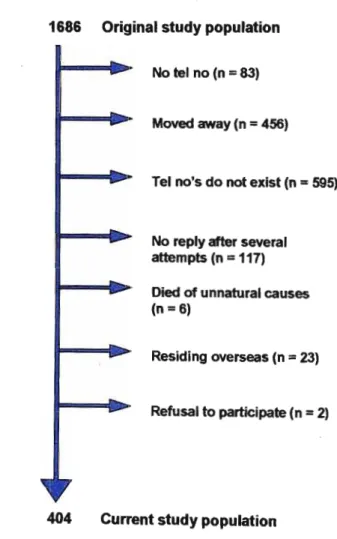
Data Collection
Data Management
Missing data
A Validity of data
Statistical analysis
Ethical Aspects
The Higher Degrees Committee and the Research Ethics Committee of the Nelson R. Mandela School of Medicine at the University of Natal approved the study (H 104/03).
Umi1ations of the study
Results
Demographic and descriptive statistics of the study populatioo
LMng conditions of the study population
Houses
Possible reasons for this phenomenon may be that people are more aware of the dangers of exposure to asbestos. One of the reasons for the increase in the use of air conditioning in 2003 compared to 1990 (from 2% to 6%) may be that the respondents now live in areas where air conditioning is essential due to climatic conditions, for example the Northern Cape and KwaZulu Natal. Figure 6.6 shows that there was a decrease, but not statistically significant (p=0.096), in smoking inside houses from 1990, when 40% of households reported having smokers smoking inside the house to 2003, when 33 % of households reported having people in the household who smoke inside the house.
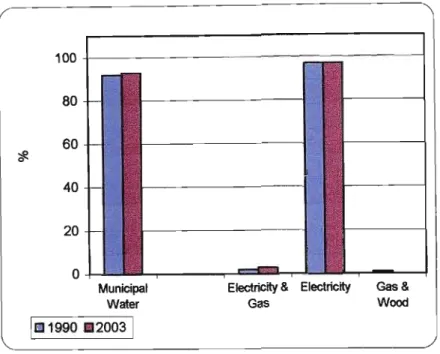
Health status of the study population .1 General health status .1 General health status
An individual who considers air pollution in the area outside the Vaal Triangle (where they live) to be severe has a 1.9 times higher risk of contracting pneumonia. The prevalence of high blood pressure (hypertension) among individuals aged 15 to 24 years in the South African population is 0.2% for men and 3.8% for women (average 2%) (SADHS, 1998). The prevalence of hyperlipidemia among individuals aged 15 to 24 years in the South African population is 0.2% for males and 0.5% for females (mean 3.5%) (SADHS, 1998).
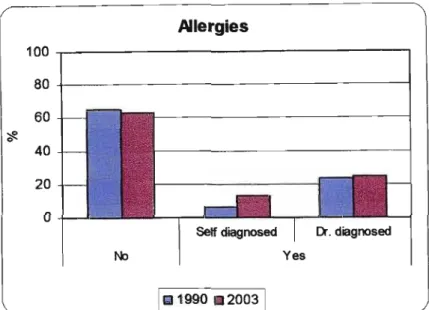
Education and social status of the study population
Eighteen percent (31/169) have at least one close family member who has suffered a stroke, while the average for the South African population between the ages of 15 and 24 is 3% (SADHS, 1998). The prevalence of family history of coronary heart disease for the population in SA between 15 and 24 years of age is 9% (SADHS, 1998). Overall, the study population in the present study had a higher prevalence of chronic diseases and a family history of chronic diseases than the average for the South African population, considering the same age group.
Personal perceptions of the study population
Discussion
Upper respiratory illnesses
Pollen and fungal spores are risk factors for the occurrence of hay fever, as was found in the YAPS study (Ozkaynak et.al., 1994). It has been proven that people's perception of air pollution can influence their respiratory symptoms (Hunter, et. al., 2003). During VAPS, higher incidence of diseases among children was reported by parents who perceived air pollution as a serious problem (Ozkaynak et.al., 1994).
Multivariate analysis
LOYler respiratory illnesses
Pneumonia
However, confidence in both of these as risk factors for pneumonia is not very high due to a wide interval. The same two factors appeared as risk factors in stepwise logistic regression, while an additional factor, suffering from sinusitis, appeared. They found that smoking, obesity, underweight, occupational exposure (especially in men) and household fuel consumption (especially in women) appeared as risk factors in univariate analysis, but that obesity and underweight were not significant in the multivariate analysis.
Asthma
The prevalence of asthma in the present study did not exceed the average for the adult white South African population. Is there a difference in the health status of adults who have remained in the Vaal Triangle compared to those who have left the area. The prevalence of most respiratory symptoms within the total study population increased from childhood with no statistically significant difference between those who remained in the area and those who left.
Concllisions and Recommendations 8.1 Conclusions
Information brochure written by the Vaal Triangle Air Pollution and Health study department. Air Pollution and Health Studies in America and Europe (In McGranahan and Murray, F. eds). Preliminary results of exposure measurement and health effects from the Vaal Triangle Air Pollution Health Study.
Design and operation of an air pollution monitoring network in the Vaal Triangle Air Pollution Health Study. Do you participate in any of the following activities twice or more per week (select Yes or No for each activity).
